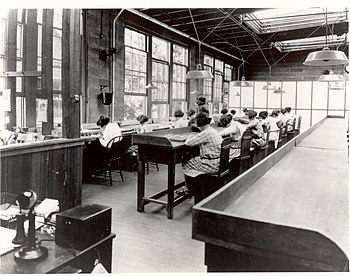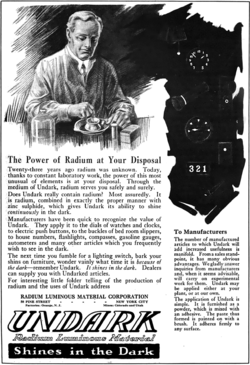Radium Girls
From Wikipedia, the free encyclopedia
This article is about the factory workers. For the illusion, see
Radium Girl.
Radium dial painters working in a factory
The
Radium Girls were female factory workers who contracted
radiation poisoning from painting watch dials with
self-luminous paint at the
United States Radium factory in
Orange, New Jersey, around 1917. The women, who had been told the paint was harmless, ingested deadly amounts of
radium
by licking their paintbrushes to give them a fine point; some also
painted their fingernails and teeth with the glowing substance.
Five of the women challenged their employer in a case that established the right of individual workers who contract
occupational diseases to sue their employers.
United States Radium Corporation
1921 advertisement for Undark
From 1917 to 1926, U.S. Radium Corporation, originally called the
Radium Luminous Material Corporation, was engaged in the extraction and purification of
radium from
carnotite ore to produce
luminous paints, which were marketed under the brand name "
Undark". As a
defense contractor, U.S. Radium was a major supplier of
radioluminescent watches to the military. Their plant in Ottawa,
Illinois,
employed more than a hundred workers, mainly women, to paint radium-lit
watch faces and instruments, misleading them that it was safe.
Radiation exposure
The U.S. Radium Corporation hired approximately 70 women to perform
various tasks including the handling of radium, while the owners and the
scientists familiar with the effects of radium carefully avoided any
exposure to it themselves; chemists at the plant used lead screens,
masks and tongs.
[1] U.S. Radium had even distributed literature to the medical community describing the “injurious effects” of radium.
An estimated 4,000 workers were hired by corporations in the U.S. and
Canada to paint watch faces with radium. They mixed glue, water and
radium powder, and then used
camel hair brushes
to apply the glowing paint onto dials. The then-current rate of pay,
for painting 250 dials a day, was about a penny and a half per dial
(equivalent to $0.277 in 2016). The brushes would lose shape after a few
strokes, so the U.S. Radium supervisors encouraged their workers to
point the brushes with their lips, or use their tongues to keep them
sharp. For fun, the Radium Girls painted their nails, teeth and faces
with the deadly paint produced at the factory.
[2] Many of the workers became sick. It is unknown how many died from exposure to radiation.
Radiation sickness
Many of the women later began to suffer from
anemia, bone fractures and
necrosis of the jaw, a condition now known as
radium jaw.
It is thought that the X-ray machines used by the medical investigators
may have contributed to some of the sickened workers' ill-health by
subjecting them to additional radiation. It turned out at least one of
the examinations was a ruse, part of a campaign of
disinformation started by the defense contractor.
[1]
U.S. Radium and other watch-dial companies rejected claims that the
afflicted workers were suffering from exposure to radium. For some time,
doctors, dentists, and researchers complied with requests from the
companies not to release their data. At the urging of the companies,
worker deaths were attributed by medical professionals to other causes;
syphilis, a notorious
sexually transmitted disease at the time, was often cited in attempts to smear the reputations of the women.
[3]
Significance
Litigation
The story of the abuse perpetrated against the workers is
distinguished from most such cases by the fact that the ensuing
litigation was covered widely by the media. Plant worker
Grace Fryer
decided to sue, but it took two years for her to find a lawyer willing
to take on U.S. Radium. Even after the women found a lawyer, the
slow-moving courts held out for months. At their first appearance in
court on January 1928, two women were bedridden and none of them could
raise their arms to take an oath. A total of five factory workers –
Grace Fryer, Edna Hussman, Katherine Schaub, and sisters Quinta McDonald
and Albina Larice – dubbed the Radium Girls, joined the suit. The
litigation and media sensation surrounding the case established
legal precedents and triggered the enactment of regulations governing
labor safety standards, including a baseline of "
provable suffering".
Historical impact
The Radium Girls saga holds an important place in the history of both the field of
health physics and the
labor rights movement.
[citation needed]
The right of individual workers to sue for damages from corporations
due to labor abuse was established as a result of the Radium Girls case.
[citation needed] In the wake of the case, industrial safety standards were demonstrably enhanced for many decades.
[citation needed]
The case was settled in the autumn of 1928, before the trial was
deliberated by the jury, and the settlement for each of the Radium Girls
was $10,000 (equivalent to $138,000 in 2016) and a $600 per year
annuity (equivalent to $8,300 in 2016) while they lived, and all medical
and legal expenses incurred would also be paid by the company.
[4][5]
The lawsuit and resulting publicity was a factor in the establishment of
occupational disease labor law.
[6]
Radium dial painters were instructed in proper safety precautions and
provided with protective gear; in particular, they no longer shaped
paint brushes by lip and avoided ingesting or breathing the paint.
Radium paint was still used in dials as late as the 1960s.
[7]
Scientific impact
Robley D. Evans made the first measurements of exhaled
radon and radium excretion from a former dial painter in 1933. At
MIT he gathered dependable body content measurements from 27 dial painters. This information was used in 1941 by the
National Bureau of Standards to establish the
tolerance level for radium of 0.1
μCi (3.7
kBq).
The Center for Human Radiobiology was established at
Argonne National Laboratory
in 1968. The primary purpose of the Center was providing medical
examinations for living dial painters. The project also focused on
collection of information and, in some cases,
tissue samples
from the radium dial painters. When the project ended in 1993, detailed
information of 2,403 cases had been collected. No symptoms were
observed in those dial painter cases with less than 1,000 times the
natural
226Ra levels found in unexposed individuals, suggesting a
threshold for radium-induced malignancies.
[8]
Literature and film
- The story is told in Eleanor Swanson's poem Radium Girls, collected in A Thousand Bonds: Marie Curie and the Discovery of Radium (2003, ISBN 0-9671810-7-0)
- D. W. Gregory told the story of Grace Fryer in the play Radium Girls, which premiered in 2000 at the Playwrights Theatre in Madison, New Jersey.
- There is an elaborate reference to the story in the Kurt Vonnegut novel Jailbird (1979, ISBN 0-385-33390-0)
- Poet Lavinia Greenlaw has written on the subject in The Innocence of Radium (Night Photograph, 1994)
- Historian Claudia Clark wrote an account of the case and its wider historical implications: Radium Girls: Women and Industrial Health Reform, 1910–1935 (published 1997).
- Ross Mullner's book Deadly Glow: The Radium Dial Worker Tragedy describes many of the events (1999, ISBN 0-87553-245-4)
- The story is told by Jo Lawrence in her short animated film "Glow" (2007)
- The story is referenced in the 2006 film Pu-239
- The Michael A. Martone short story It's Time is told from the perspective of an unnamed Radium Girl
- A fictionalized version of the story was featured in the Spike TV show 1000 Ways to Die (#196)[9] and Science Channel's Dark Matters: Twisted But True
- Radium Halos: A Novel about the Radium Dial Painters a 2009 novel by Shelley Stout is historical fiction narrated by a sixty-five-year-old mental patient who worked at the factory when she was sixteen (ISBN 978-1448696222).
- Author Deborah Blum referenced the story in her 2010 book The Poisoner's Handbook: Murder and the Birth of Forensic Medicine in Jazz Age New York.
- The story is told in the American Experience episode The Poisoner's Handbook, based on Deborah Blum's book.
- Author Robert R. Johnson features a story on the radium girls in his book Romancing the Atom. (ISBN 978-0313392795) [10]
- The Case of the Living Dead Women, a website displaying scans of 180 pages of newspaper clippings about a similar incident, the Ottawa, Illinois Radium Dial Company litigation[11]
- The Radium Dial Company workers' story is dramatized in Melanie Marnich's stage play These Shining Lives.
- A fictionalized version of the story was featured in the 1937 short story "Letter to the Editor" by James H. Street, adapted into a 1937 film Nothing Sacred and a 1953 Broadway musical Hazel Flagg.
See also
References



No comments:
Post a Comment